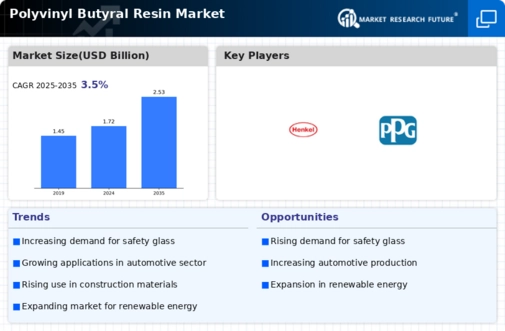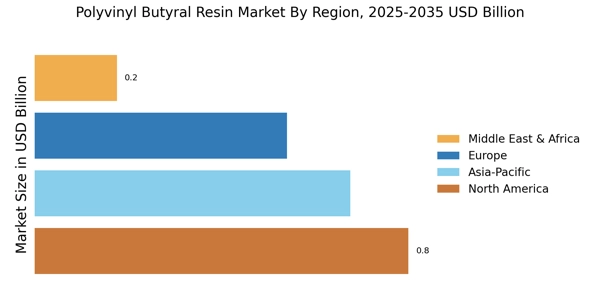Growth in Renewable Energy Sector
The Polyvinyl Butyral Resin Market is also benefiting from the growth in the renewable energy sector, particularly in the production of solar panels. Polyvinyl Butyral is utilized as an encapsulant in photovoltaic modules, providing protection and durability to solar cells. As the world increasingly shifts towards sustainable energy solutions, the demand for solar energy is on the rise, which in turn boosts the need for high-quality encapsulants. By 2025, the renewable energy segment is anticipated to contribute significantly to the overall market, driven by government initiatives and investments in clean energy technologies. This trend underscores the resin's versatility and its critical role in supporting sustainable development.
Rising Demand in Automotive Safety Glass
The Polyvinyl Butyral Resin Market is significantly influenced by the automotive sector, particularly in the production of safety glass. The increasing focus on passenger safety has led to a surge in the use of laminated glass in vehicles, which incorporates Polyvinyl Butyral as an interlayer. This resin not only provides structural integrity but also enhances the glass's ability to withstand impact. As of 2025, the automotive segment is expected to represent a considerable portion of the overall market, driven by stringent safety regulations and consumer preferences for advanced safety features. The trend towards electric and autonomous vehicles further propels the demand for high-performance laminated glass, thereby benefiting the Polyvinyl Butyral Resin Market.
Increasing Use in Architectural Applications
The Polyvinyl Butyral Resin Market is experiencing a notable increase in demand due to its extensive use in architectural applications. This resin is primarily utilized in laminated glass, which is favored for its safety and aesthetic qualities. The architectural sector is increasingly adopting laminated glass for facades, skylights, and interior partitions, driven by a growing emphasis on safety and energy efficiency. In 2025, the architectural segment is projected to account for a substantial share of the market, reflecting a shift towards modern building designs that prioritize both functionality and visual appeal. Furthermore, the integration of Polyvinyl Butyral in construction materials enhances sound insulation and UV protection, making it a preferred choice among architects and builders.
Expanding Applications in Consumer Electronics
The Polyvinyl Butyral Resin Market is witnessing an expansion in applications within the consumer electronics sector. The resin is increasingly used in the production of screens and displays, where it serves as a protective layer that enhances durability and optical clarity. With the proliferation of smart devices and the demand for high-quality displays, the need for Polyvinyl Butyral is expected to grow. In 2025, the consumer electronics segment is projected to account for a notable share of the market, driven by trends such as miniaturization and the increasing importance of aesthetics in electronic products. This expansion highlights the resin's adaptability and its potential to meet the evolving needs of the electronics industry.
Technological Advancements in Manufacturing Processes
Technological advancements in the manufacturing processes of Polyvinyl Butyral are playing a crucial role in shaping the Polyvinyl Butyral Resin Market. Innovations in production techniques are enhancing the quality and efficiency of resin production, leading to improved performance characteristics. These advancements allow for the development of specialized grades of Polyvinyl Butyral that cater to specific applications, such as high-temperature resistance or enhanced adhesion properties. As manufacturers adopt more sophisticated technologies, the market is likely to witness a diversification of product offerings, which could attract new customers and applications. This trend is expected to contribute positively to the market's growth trajectory in the coming years.


















Leave a Comment